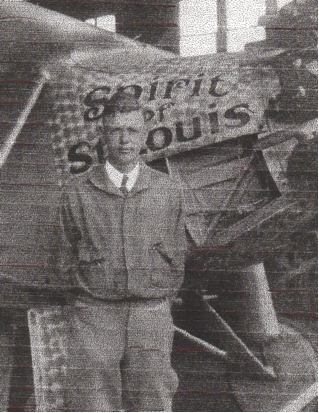“We” (Lindbergh over Youngstown)

Within one month after Charles A. Lindbergh’s (1902-1974) heroic flight across the Atlantic Ocean in a single engine airplane, he accepted an offer to write a “quickie” book about his early life and his transatlantic trip. This book was fittingly entitled “We”. In its Foreword Myron Herrick, U.S. Ambassador to France, wrote, “…all the praise awarded him, judged by the rigid standard of history and precedent, he was merited…for he was needed and he came at a moment which seemed exactly preordained”. That moment was 7:54 AM on May 20, 1927, the time when Lindbergh took off from Roosevelt Airfield, Long Island, and headed his monoplane toward Paris. Lindbergh modestly writes, “The field was little soft due to rain during the night and the heavily loaded plane gathered speed very slowly. After passing the half-way mark, however, it was apparent that I would be able to clear the obstructions at the end. I passed over a tractor by about fifteen feet and a telephone line by about twenty, with a fair reserve of flying speed…I turned slightly to the right to avoid some high trees on a hill directly ahead, but by the time I had gone a few hundred yards I had sufficient altitude to clear all obstructions and throttled the engine down to 1750 R.P.M.”
The plane Lindbergh flew was built in San Diego, California in only 60 days by the Ryan Aircraft Company. It had a top speed of 129 mph and could carry 400 gallons of gasoline or twice its empty weight. It had a wing span of 46 feet and a length of 27 feet and cost Lindbergh’s backers $15,000. Today the “Spirit of St. Louis hangs along side the Wright brother’s “Flyer” and the Apollo 11 command module in the National Air & Space Museum in Washington D.C.
In the summer of 1927 “Slim”, as his admirers called him, flew his Ryan NYP (New York Paris) on a tour of 49 American States stopping at 92 cities along the way. On this tour he gave 147 speeches and rode 1,290 miles in parades. It is estimated that a quarter of our country’s population saw his plane as it circled city after city. On August 3rd Lindbergh took off from Cleveland Municipal Airport and headed for Pittsburgh. On this flight he flew over Akron, Canton, Alliance, and arrived over Youngstown at 12:07. He circled four times at about 200 feet above the tops of the downtown buildings and on the last pass dropped a message for Mayor Scheible that landed in the southeast corner of the square. The Spirit of St. Louis then headed for New Castle and was last seen climbing over the smoke from the steel mills in Campbell. Undoubtedly many Poland residents looked up that day and saw this tiny silver plane as it headed east..
Oh yes! On June 16, 1927 the group of St. Louis investors collected their $25,000 prize money ($250,000 today) from Raymond Orteig, a fat and friendly Frenchman who operated the Brevoort and Lafayette hotels in New York City. Orteig had made his offer in 1919, but no aviator had succeeded in flying non-stop across the Atlantic from New York to Paris until Lindbergh’s historic flight eight years later. Vacuum Oil Company awarded Lindbergh another $25,000 for an endorsement of the oil he used in the plane’s engine. In every city where he landed the Spirit of St. Louis the local authorities gave awards and honors to this famous young man now called the “Lone Eagle”. Lindbergh modestly accepted these awards and later donated them to the Missouri Historical Society where they may be seen today on display in the Jefferson Memorial in St. Louis. An original copy of his book, “We”, is proudly displayed on my library’s top shelf.
